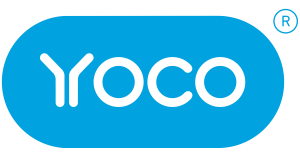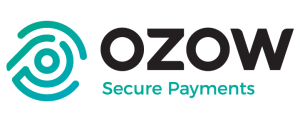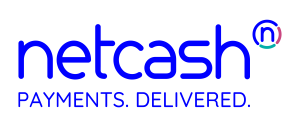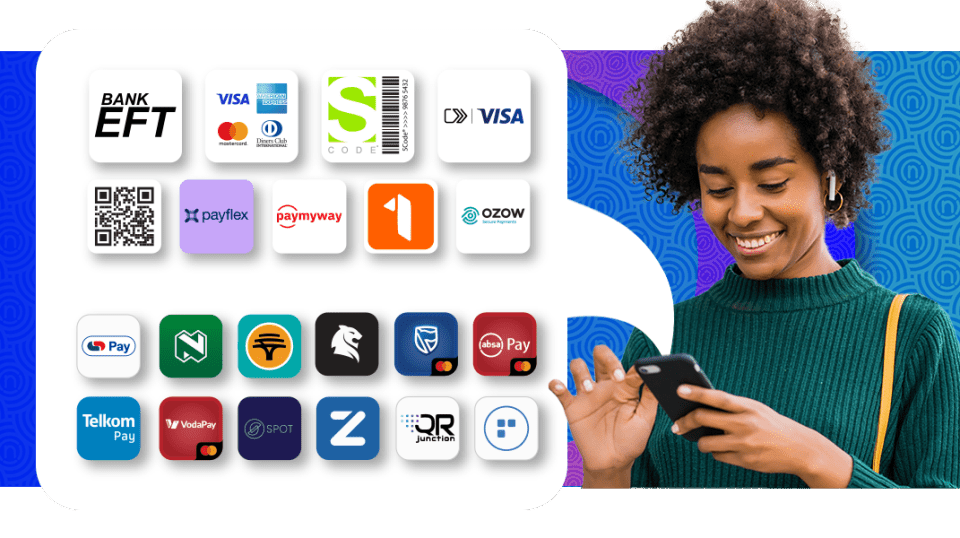
eCommerce payment statistics South African businesses should track
October 24, 2025
Payment fraud trends and how to protect your business
October 31, 2025The emergence of digital payments has taken the world by storm, and South Africa is not an exception. According to Stats SA, over 70% of adults engaged with a digital payment method between 2022 and 2024, highlighting a growing appetite for cashless, online payment options.
Own a small business that does not accept online payments? You’re falling behind, while competitors are cashing in. But you’ve come to the right place. This practical guide walks businesses like yours through the tools, steps, and best practices for accepting online payments.
Ready to improve customer satisfaction and maintain a healthy cash flow? Let’s dive in!
P.S. Just started? Here’s how to set up online payment options for small businesses.
Find your perfect payment match.
Discover the best option for your business now.
Getting started: What you need to accept online payments
Before we dive into the nitty-gritty of setting up your business to accept payments online, let’s start with the basics. Several steps must be taken before you can start accepting digital payments in South Africa.
Have the following ready before jumping into the step-by-step guide:
- Online store or website: You need an eCommerce platform to showcase your products or services and facilitate online transactions. You can choose between many platforms, including WooCommerce, Ecwid, and Shopify. Ensure your website or platform is mobile-friendly to keep pace with the growing trend of mobile commerce, which is the buying or selling of goods or services through handheld devices like phones and tablets.
- Payment gateway: This facilitates transactions between your website and payment processors. The payment gateway you choose should be secure and have encryption to protect sensitive data.
- Merchant account: This is separate from your standard business account. It holds funds during transactions to act as a buffer for refunds and chargebacks. It’s not always required, but good to have so that all funds going to your business account stay there.
- Payment methods: You can offer various payment methods to your customers. Card payments are by far the most popular for online transactions, but it’s highly encouraged to provide newer methods like Buy Now, Pay Later (BNPL), QR codes, and Vouchers.
- Security: You must protect your customers’ sensitive information. Ensure your payment gateway is Payment Card Industry Data Security Standard (PCI DSS) compliant, offers 3D Secure authentication, includes fraud detection and prevention measures, and has good customer service.
A quick note: payment service providers vs. direct integration
It’s important to note the difference between payment service providers (PSPs) and direct integration. A payment service provider offers a convenient, streamlined approach and often handles all the technical and security aspects for you. So you can focus on your core business.
On the other hand, direct integration provides more control, flexibility, and customisation, but requires more technical expertise. You can tailor payment solutions for your target audience.
Benefits of payment service providers (PSPs):
- Convenience and ease of use
- Wide range of payment methods
- Global reach
- Security and compliance
- Reporting and analytics
Benefits of direct integration:
- Customisation and control
- Deeper data access
- Potentially lower transaction fees
If you’re looking to make management easier by consolidating multiple payment options into one platform, then payment service providers are your best bet. They increase conversions with diverse payment methods, seamless checkouts, and fraud detection and compliance features.

Best payment gateways in South Africa
Now that you’re all clued up on what you need to start accepting online payments, let’s have a look at the various payment gateway options available in South Africa. Below is a comparison table to help you compare payment gateways side-by-side on their costs, pros, and cons.
|
Payment gateway |
Transactions fees |
Accepted payment methods |
Key benefits |
Disadvantages |
|
|
3.2% plus R2.00 for card
|
|
|
Not the cheapest transaction fees |
|
|
|
|
|
|
|
|
1.5% or a minimum of R1 on all transactions across all banks;
|
|
|
|
|
|
2.5% to 2.9% (excl VAT) |
|
|
Customers need the Zapper app |
|
|
2.55%* to 2.95% (excl VAT) |
|
Widely accepted in retail stores |
Customers need the SnapScan app |
|
|
3,5% fee for merchants
|
|
Offers a credit facility;
Merchants: There are no other setup or joining fees |
Customers:
|
|
|
5.25% + R4 + R1.50 per transaction |
Visa, Mastercard, American Express (debit, credit, cheque cards)
|
|
|
|
|
2.95% + R1.50 Local Mastercard, Visa & AmEx Cards (3DSecure);
|
|
|
Focused on larger businesses |
|
|
Competitive rates on all payment methods;
|
|
|
|
Tip: When choosing a payment gateway, ensure the cost, security, payment methods, integration, and customer support align with your business’s needs and resources.
Start unlocking growth today.
Speak to one of our Payments Advisors and discover the best option for your business.
Step-by-step guide: Setting up your online payments
Once you’ve analysed the best payment gateways in South Africa, you’ll be ready for the next phase. This step-by-step guide walks you through setting up your website or eCommerce platform to start accepting payments from customers online via multiple payment methods.
1. Choose a payment gateway
This is a crucial step, as the decision you make can accelerate your sales or be a stumbling block. Pick a payment gateway provider that can easily integrate with your systems, offers multiple online payment solutions, and provides secure online payments and fraud protection.
Take a close look at the pricing structure before picking a payment gateway. Fees can creep up, eating into your profits and ultimately disrupting your cash flow. It’s also essential to choose a payment gateway with excellent reporting capabilities. From that data, you’ll get insights that you can use to optimize your checkout process to reduce abandoned carts and improve sales.
2. Set up a merchant account
Depending on the payment gateway you choose, you may need to set up a merchant account to access critical resources such as an interactive dashboard, analytics, and even APIs. This acts as a business account that holds funds temporarily. It safeguards you from chargebacks and other fees before funds are transferred to your business account at a bank of your choice.
3. Integrate the payment gateway
Most payment gateways have easy-to-follow guides on how to integrate them with your systems. Some offer plugins for WooCommerce payment gateway integrations, while custom websites may require the payment gateway’s API to integrate online payment systems.
4. Enable payment methods
There are many online payment methods you can choose to accept on your website. It’s advisable to enable as many options as possible to cater to a broader audience. Enable tried-and-tested methods like card payments, Instant ETFs, and Scan to Pay, using QR codes.
Allow payments from newer solutions, including Buy Now, Pay Later via Payflex, digital wallets like Apple Pay and Samsung Pay, real-time payments with PayShap, and accept vouchers. With these, you can attract tech-savvy customers, budget-conscious buyers, and unbanked people.
Payment links are also worth enabling. This functionality allows you to send payment requests and reminders to your customers via SMS, WhatsApp, email, or QR code to ensure you get paid on time. These work excellently for one-off payments and recurring bills.
5. Run a payment test
Before launching your website or eCommerce platform, it’s important to test all the payment methods to ensure they are working correctly. While testing, analyse the user experience, note the choke points that could potentially lead to an abandoned cart, and optimise accordingly.

Security tips to protect your business and customers
The world of online payments comes with many benefits, but there are drawbacks. As the way people transact evolves, criminality follows. So here are a few tips on how you can protect your online business as well as your customers when accepting online payments.
- Work with PCI DSS-compliant providers: Ensure your payment gateway or processor meets international and local security standards (POPIA, SARB directives).
- Confirm encryption and tokenisation are in place: These are technical safeguards your provider should handle automatically.
- Check for 3D Secure (3DS) support: Most South African card transactions require this extra authentication step.
- Enable strong authentication (2FA/MFA): Add extra login security for your admin dashboards, eCommerce platform, and staff accounts.
- Keep your website and plugins updated: Regularly update your eCommerce platform, CMS, and security patches.
- Limit staff access: Only grant financial dashboard or payment data access to trusted employees.
- Rely on your provider’s fraud detection tools: AI-driven and real-time transaction monitoring should be included by your payment gateway.
- Verify transactions directly in your provider dashboard: Don’t rely on emailed payment proofs or screenshots before releasing goods.
- Protect against tampering: If you use QR codes or point-of-sale tools, enable instant verification with your provider’s system.
- Educate staff and customers: Ensure employees can identify phishing, fake confirmations, or social engineering attempts.
- Have a clear payment policy: Communicate to customers that you only accept verified payments through official channels.
- Follow POPIA and SARB’s Cybersecurity Directive: Your provider should lead compliance, but you must ensure your business processes align.
- Schedule regular audits and risk reviews: Even if technical scanning is handled by your provider, you can review internal practices.
- Stay aware of emerging fraud trends: Criminal tactics evolve; awareness is your best first defence.
- Maintain secure, encrypted backups: Keep a copy of key financial records and customer payment histories. Your provider secures their systems, but you should secure your business data.
Frequently Asked Questions
Accepting payments online in South Africa: Wrapped up
Accepting payments online doesn’t have to be complicated. By choosing a reputable South African payment gateway and following best practices like strong authentication, staff training, and policy enforcement, you’ll protect both your business and your customers.
Security is a shared responsibility: your provider handles the heavy technical lifting, while you set the right processes and awareness in place.
When done right, online payments become not only safe but also a powerful way to grow your business with confidence.
Simplify your checkout process with a trusted South African payment gateway.

Bennie Bester is a Solutions Architect at Netcash, specialising in designing and implementing innovative payment and integration solutions. With a passion for technology and efficiency, Bennie focuses on creating seamless systems that empower businesses to simplify payments, improve processes, and scale with confidence.











